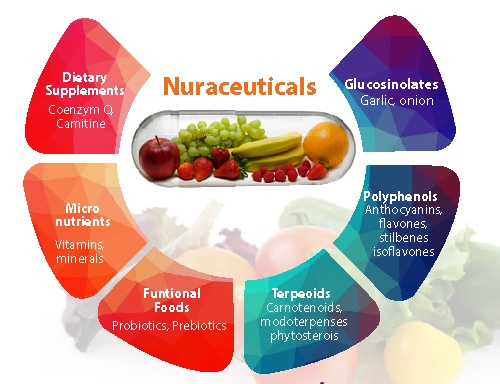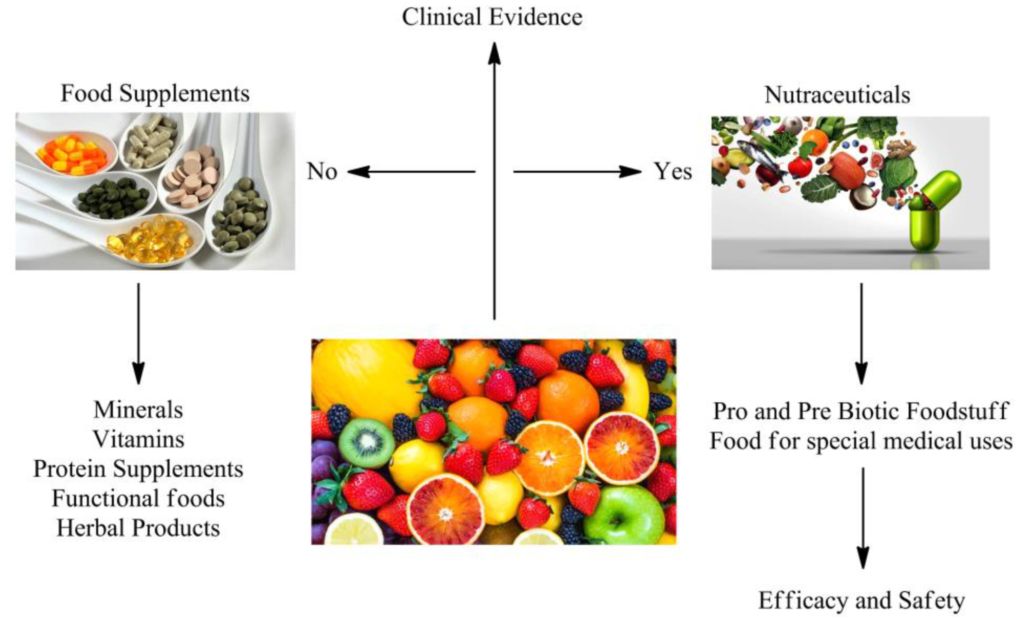The word “nutraceutical” has been in use for a long time. In terms of marketing, a “Nutraceutical” is a nutritional supplement that has been created with the goal of curing or preventing disease. They come in a wider variety, starting with isolated nutrients and moving on to dietary supplements, processed foods, and even genetically altered “designer” foods. Potentially, nutritional supplements can improve health. It even slows down the ageing process and protects against chronic illnesses, extending life expectancy. The compounds used to prevent illness are known as Nutraceuticals and are often not patented. These compounds are utilised for health purposes in addition to nourishment. Accordingly, in terms of definition, we may say that a “nutraceutical” is a full food item or a portion of it that has health and medical advantages for us, and is therefore utilized to prevent sickness.
❖ Nutraceutical Benefits
1. Nutraceuticals aid in illness prevention.
2. Assist customers in getting their recommended daily intake of vitamins and minerals.
3. These are less harmful than traditional medications.
4. They are affordable and widely accessible.
❖ Limitations Of Nutritional Supplements
1. Nutraceuticals can be purchased without a prescription and are widely available. These are regarded as food, not as a substance. One of the main drawbacks is the existence of adulterations brought on by a lack of pharmaceutical quality control.
2. The nutraceutical dose and quality are unclear.
3. The cost of its manufacture is still another issue.
4. A nutraceutical may fall under the definition of a medication under European Medicines Law for one of two reasons:
➢ It may be used to treat and prevent many conditions and diseases.
➢ It can be provided to restore, rectify, or change a person’s physiological functioning.

❖ Classification:
There are several ways to categories nutraceuticals, including:-
1. Access to scientific information
2. Food’s origin
3. Considering the mode of action
4. Considering chemistry
General categories for nutraceuticals include:
1. Possible nutraceuticals
2. Trustworthy nutraceuticals

A prospective nutraceutical is a food or supplement with medicinal potential or positive health effects. When there is enough clinical evidence to support a putative Nutraceutical advantages, it is considered to have been established. Due to a lack of available literature, the majority of nutraceutical products fall within the category of prospective ones. Dietary fibre, prebiotics, probiotics, omega-3 fatty acids, and antioxidants are examples of dietary items that fall under the area of nutraceuticals.
❖ Nutraceuticals Can Be Studied Under The Following 3 Broad Categories Such As:-
➢ Nutrients – Compounds known as nutrients, which include fatty acids, amino acids, vitamins, and minerals, have been shown to have nutritional roles. This includes various natural antioxidants, prebiotics, probiotics, polyunsaturated fatty acids, and dietary fibre.
➢ Herbals – Since the beginning of time, people have used herbs as all-natural cures for a wide range of illnesses. Herbs naturally have the power to treat sickness and can be useful to humans, according to the conventional medical paradigm. Numerous studies have looked at the biological activity and toxicity of chemical elements found in plants. Among the phytochemicals in this class are herbal and botanic stuff.
Green tea is a key ingredient in enhancing both humoral and cell-mediated immunity. Strong antioxidant properties are present in it. In addition to phenolic chemicals, sulphur compounds, pigments, various phytoconstituents, including terpenoids, herbs may also include whole grains, vegetables, fruits, nuts, and seeds. These are diverse herbal and botanical extracts and concentrations.
➢ Dietary supplements – These include compounds with specialised purposes, such as meal replacements, weight loss aids, and sports nutrition, such as pyruvate, chondroitin sulphate, and other substances obtained from diverse sources.
Dietary fibre is sometimes referred to as bulk and roughage. The body has a hard time digesting plant portions known as roughages. Fruits, vegetables, bean products, whole grains, and legumes are incredibly high in dietary fibre. It is important to avoid or treat constipation as soon as possible. Fibres come in two varieties: soluble and insoluble.
❖ Phytochemicals
The bio-active elements of plants are phytochemicals, which promotes the growth of a good health. They have great demand in the pharmaceutical industry. Numerous foods as cereals, vegetables, and beans, are abundant sources of phytochemicals and may be employed as nutraceuticals. The term “phytochemical” emphasises how some of the chemicals that protect health originate from plants.
❖ Phytochemical Roles
- They act as a substrate for a variety of biological functions.
- Used to bind and eliminate undesirable intestinal components.
- Promotes increased nutritional stability and absorption.
- They eliminate dangerous intestinal bacteria.
- Take up scavenging.
❖ Nutraceuticals’ Impact On Disease Prevention
1. Cardiovascular disease:
Antioxidants, dietary fibre, Omega-3 polyunsaturated fatty acids, minerals, and vitamins are used to prevent and cure cardiovascular disease. Polyphenol, which is found in grapes, helps to prevent and treat arterial diseases. Foods like onions, grapes, red wine, apples, and cherries include flavonoids that function to block the renin-angiotensin system and strengthen the tiny capillaries that supply all cells with oxygen and nutrients.
Rice bran helps to lower the bad cholesterol (LDL) and increase the good cholesterol (HDL), which lowers the blood serum cholesterol level. Rice bran contains lutein and zeaxanthin, which help to enhance vision and reduce the risk of cataracts. For sustaining eye health, rice bran’s omega-3, omega-6, omega-9, and folic acid components are also essential. Low fruit and vegetable consumption is connected to greater CVD mortality and diet-related diseases. Diet-related disorders are on the rise right now as a result of rising high-calorie food consumption and sedentary lifestyles. Atherosclerosis, hypertension, obesity, and nerve degeneration are only a few of the illnesses connected to nutrition.
2. Heart and Lung cancer:
Corn has significant amounts of fibre and folates. Corn sustains the elevated homocysteine levels that result in blood vessel damage, heart attacks, strokes, and peripheral vascular disease. Research suggests that consuming 100% of the daily recommended amount of folate may reduce the risk of heart attacks by 10%. The natural pigment cryptoxanthin, one of the components of maize, reduces the risk of lung cancer.
3. Obesity:
The accumulation of unhealthful and excessive body fat is the hallmark of the global health problem known as obesity. Increased blood pressure, angina pectoris, CHF, respiratory problems, osteoarthritis, the emergence of malignant cells, hyperlipidemia, and other risk factors are some of the outcomes.
4. Diabetes:
Diabetic neuropathy can be treated with the antioxidant lipoic acid. Dietary fibres from psyllium are used to control blood sugar in diabetics and lower lipid levels in cases of hyperlipidemia.
5. Cancer:
Flavonoids shield against estrogen-induced cancers by inhibiting the enzymes that create oestrogen. Breast and prostate cancer may be prevented by them. Cancer can be avoided by consuming curcumin, which is found in soy foods like curry and soy isoflavones. Lycopene accumulates in the prostate, testicles, adrenals, and epidermis, all of which are cancer-fighting tissues.
6. Anti-Inflammatory:
The polyphenol curcumin found in turmeric possesses anti-inflammatory, antioxidant, and anti-carcinogenic properties. The anti-tumor capabilities of beetroot root, cucumber, spinach leaves and turmeric rhizomes are all similar. Gamma linolenic acid is used to treat autoimmune diseases and to reduce inflammation. It is present in green leafy vegetables and vegetable-derived oils (evening primrose oil, blackcurrant, and hemp seed oil). Glucosamine and chondroitin sulphate are used to combat osteoarthritis.
7. Parkinson’s condition:
For the purpose of preventing Parkinson’s disease, vitamin E must be present in meals. Parkinson’s disease could possibly be treated with even creatine. Significant findings from preliminary study on nutritional supplements were found. Due to a dearth of data, it is currently not recommended for Parkinson’s disease.
8. Osteoarthritis:
Osteoarthritis (OA) is one of the most widespread joint conditions. People with OA and other joint conditions may become less active, which might result in weight increase. The increase in weight put extra strain on the joints. Osteoarthritis can be prevented by taking glucosamine and chondroitin sulphate (CS and GLN).
|
S.No |
Product | Category | Benefit | Manufacturer |
|
1 |
Glucon D | Glucose | Energy provider | Heinz |
|
2 |
Proteinex |
Protein and
nutritional supplement |
Both physical and mental growth |
Pfizer |
|
3 |
GRD | Nutritional supplement | Tissue growth and repair | Zydus |
|
4 |
Tropicana | Energy drink | Full of nutrients | Tropicana
Products |
|
5 |
B-Protein | Nutritional supplement | Formation of haemoglobin | British Biologicals |
|
6 |
Cod liver Oil | Omega 3 fatty acids | Immunity booster | Sanofi |
|
7 |
Revital | Health supplement | Improve health and
immunity |
Ranbaxy |
|
8 |
Pediasure | Nutritional supplement | Helps in child growth | Abott |
|
9 |
Threptin diskette | Protein supplement | Ensures protein nutrition in body | Raptakos Brett & Co |
Table: Commercially available Nutraceuticals














